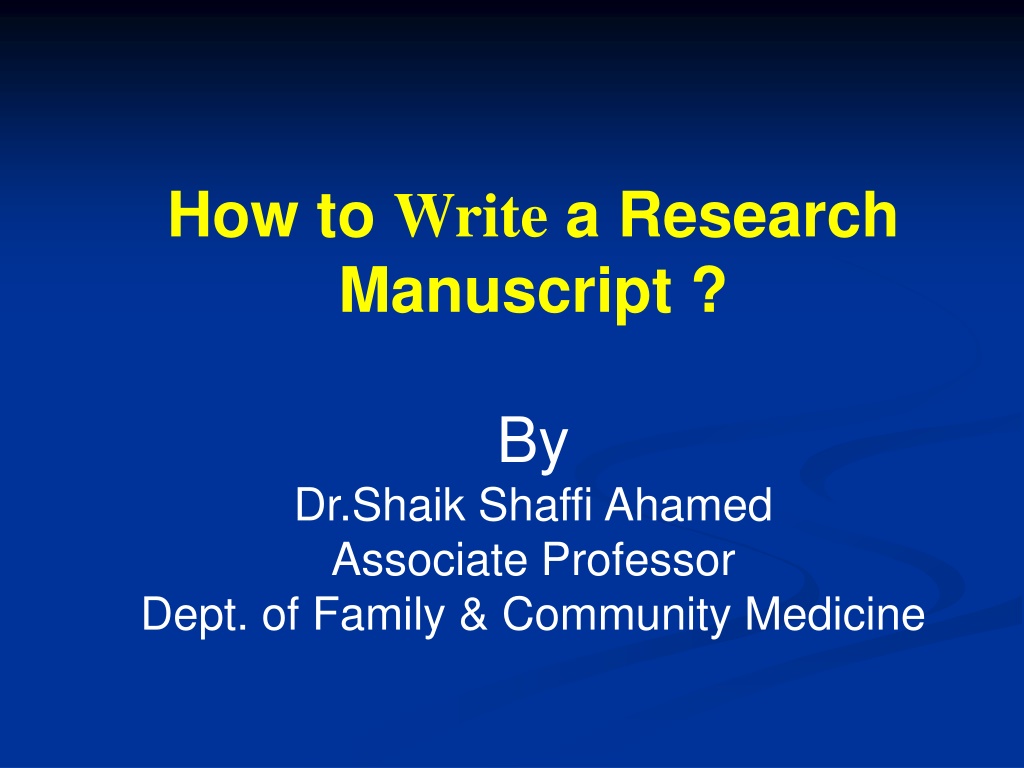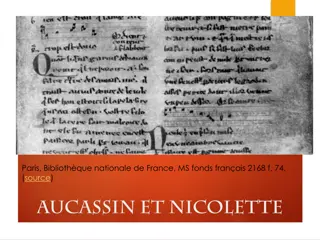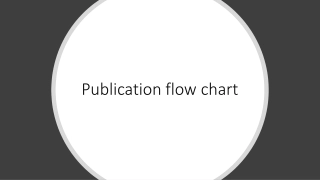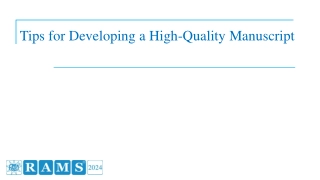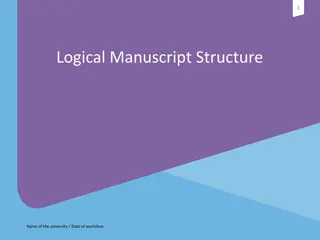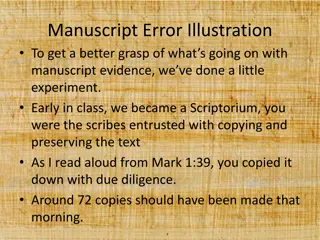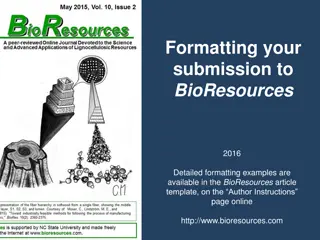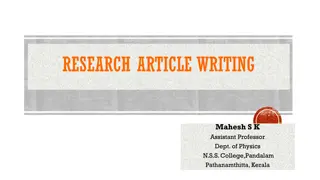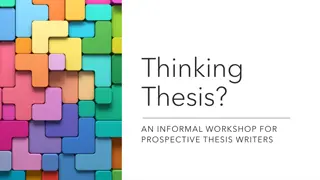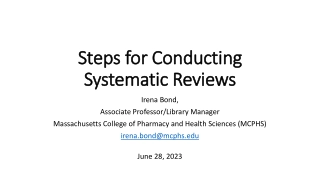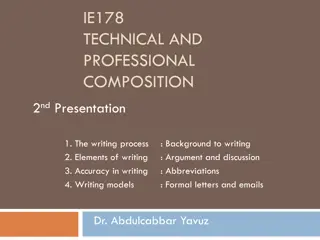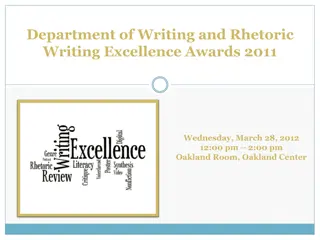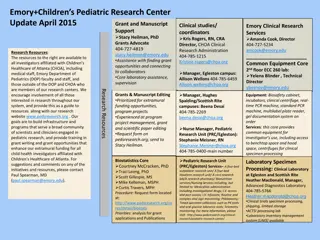Guide to Writing a Research Manuscript
Writing a research manuscript involves various key components such as background reading, structuring the manuscript, focusing on methods and results, and ensuring comprehensive details are provided. It is essential to follow a systematic approach from the introduction to the discussion to effectively communicate your research findings in a clear and concise manner.
Download Presentation

Please find below an Image/Link to download the presentation.
The content on the website is provided AS IS for your information and personal use only. It may not be sold, licensed, or shared on other websites without obtaining consent from the author. Download presentation by click this link. If you encounter any issues during the download, it is possible that the publisher has removed the file from their server.
E N D
Presentation Transcript
How to Write a Research Manuscript ? By Dr.Shaik Shaffi Ahamed Associate Professor Dept. of Family & Community Medicine
Writing a Paper: Getting Started The only way to learn to write is to write --Peggy Teeters No single best way Varies from paper to paper Background reading--Literature search!
Write in What Order? Parts of a Manuscript--Structure Title Abstract Introduction Methods Results Discussion References Writing is a lot easier if you have something to say --Sholem Asch
Methods Editors judge the study on whether your methods are adequate to answer your specific aim or hypothesis Rationale for choosing procedures/tests The pivotal point to judge whether the results are valid Don t suggest a method you have no expertise with Your peer reviewer may uncover this Use consultants for methods you have no experience with, stating this in paper Methods usually the weakest section Often deficient in detail, not providing enough information to replicate the study Statistical shortcomings
Methods Study design or analysis type and period of study Condition or disease studied Study subjects consent and IRB approval Details of sample (sample size, selection methods of study subjects, how organized) Interventions, outcome measures, statistical analyses Include the locations and times that data were collected Give enough information to replicate the study; don t assume only the specialist in your field will read it
ResultsThe Beginning The heart of your paper Write after figures and tables are constructed Consider your data critically Construct tables, figures and include them in outline Write the results Use subheadings Results determine Whether you ve answered your original question(s) Your direction for future studies Both of which belong in the discussion
ResultsThe Beginning State ALL the findings Whether significant or not Without bias or interpretation Do not include weaknesses, strengths of study, ie don t discuss results List experiments in order listed in methods Use logical headings and group your findings Characteristics of study subjects Findings in order listed in methods General to specific Use past tense Results confirm or reject your hypothesis: they do not prove anything.
Results Short and to the point Main or most important findings first Present only data directly relevant to the study focus Don t repeat methods but you may remind the reader briefly how you measured something. Allow the data to speak for itself use tables/figures construct them first and use as a basis for writing In Tables and Figures, be descriptive, specific. Do not repeat the obvious: NO: Results of the kidney lead analysis are shown in Table 1. YES: Kidney lead concentrations increased in group 1 over the first 10 study weeks (Table 1). Present absolute numbers and percentages so reviewers can judge the significance of the findings. Statistical significance clinical significance
Results or Data? Results Mean translational movements in the X (left to right), Y (back to front) and Z (bottom to top) head directions were 0.10 0.11 mm, 0.16 0.03 mm, and 0.65 0.58 mm, respectively. Mean rotational movements about the three axes were 0.44 0.42 degrees, 0.24 0.26 degrees, and 0.18 0.17 degrees, respectively. Movement was not significantly correlated with age for translation in the X (r = -0.09; p = 0.69), Y (r = 0.21; p = 0.35) or Z (r = -1.02; p = 0.64) directions. Movement was not significantly correlated with age for rotation in the X (r = 0.15; p = 0.51), Y (r = -0.20; p = 0.35) or Z (r = 0.02; p = 0.94) directions.
ResultsDont Regurgitate Data As shown in Table 1, the mean age of participants was 20.4 2 years, and 80% of patients were Caucasian. Treatment group contained 40 patients, whereas control group contained 45 patients. Table 2 shows the demographics of women in these groups. There were 24 women in the control group, and 33 women in the treatment group... There were no significant differences in treatment and control patient intake demographics (Table 1), although a significantly greater number of patients in the treatment group dropped from the study for a variety of reasons, mostly relating to adverse reactions. However, analysis of patients in this group later revealed that those dropped patients had significant disease at intake (Table 2). In comparing the two treatment groups (Figure 1), we found that...
Dont State the Obvious Figure 1 is a graph illustrating the plasma zinc levels ( moL/L) over the 37 weeks versus gestational age in both the zinc supplement group and placebo group. The placebo and the zinc group both decreased over the 37 weeks of the study, but the differences were significant for the zinc group.
State Whats Important We measured mothers plasma zinc levels before randomization (week 19) and at 26, 32, and 37 weeks gestational age (Fig 1). Beginning as early as 26 weeks and at each timepoint, differences in plasma zinc levels between placebo and zinc supplement groups were statistically significant (P 0.05) after randomization.
Discussion Construction Summarize major findings 1st paragraph Explain how your findings relate to those of others what do they mean? Clinical relevance of the findings? Limitations and how this influenced your study? How will you overcome these in the next studies? Explain the implications of findings What future direction(s) will you take?
Discussion: Getting Carried Away Few studies make discoveries changing the course of scientific direction, and so authors: Attempt to overly state or the importance of their findings Come to erroneous or unsupported conclusions Uncritically accept statistical results This all distracts from work s importance and signals to the reviewer problems with the research Also results in excessive length, a common problem Authors should let the data speak for themselves
DiscussionCommon Mistakes Unwarranted speculations 1. Injecting tangential issues 2. Conclusions not supported by the data 3. Not suggesting future directions for research 4. hypothesis study data/results conclusions TIGHT PACKAGE
Introduction Why did you carry out this research? State the specific purpose or rationale for the study. What is the existing state of knowledge of this topic? Synthesize information tracing the development of the problem and summarize its current state ie, the background. You ask (with citations): What s known? What s unknown? What are the gaps in knowledge this study will fill? What are you going to do and what do you expect to find? State your hypothesis or question clearly (Objectives, Aims) Give only strictly pertinent references.
Introduction This is a vital part of your paper it convinces (or not) the reader whether your study: Has merit and asks important research questions Is focused and supported by relevant recent citations Is ultimately important to human health and human disease Reviewers and editors will judge the paper s importance in the introduction. You will better focus your introduction AFTER you construct your findings (results) and consider them (discussion). Your research question is the most important part in your discussion, you will address whether the question or hypothesis was answered based on your data.
Introduction Structure 1. What is the general problem or current situation? Zinc plays a critical role in many biochemical functions, including nucleic acid metabolism and is critical in early development. 2. What is the specific problem or controversy? Its significance? Zinc deficiency is associated with increase metabolic problems in fetuses. Studies evaluating relationship between zinc intake and pregnancy outcomes have produced conflicting results for many reasons 3. What are our hypotheses/questions, and how will we answer them? To clarify the relationship between zinc levels in the mother s diet and pregnancy outcomes, we undertook a randomized placebo-controlled trial of zinc supplementation. Our objective was to determine if zinc supplementation was associated with higher birth weight. Our findings will help to provide continuing nutritional guidelines in pregnancy.
The Abstract 1st Impression to journal editor and the reader! Follow the Journal s Guidelines Most abstracts are often too long: 250 words: Cannot upload your paper! Structure it (outline it) The abstract is the single most important part of a manuscript, yet the most often poorly written -JAMA Editor
The Abstract First looked at by editors/sometimes only thing read by readers Sometimes only part available electronically KEY words! Summarizes the main points succinctly: Background/Significance Objective Study design, methods Primary results Principal conclusions, implications Do NOT be vague be substantive and brief NOT The implications are summarized INSTEAD Summarize the implications!
Abstract Emphasize methods, main results, and conclusion Introduction/purpose: 1 short sentence Put objective as imperative style: Objective: To evaluate whether zinc supplementation during pregnancy affects infant birth measures. Methods, Results: 2-4 sentences Conclusion: 1-2 sentences
Structured Abstract Context Summarize the study rationale and provide clinical (or other) reason for the study question. Objective State the purpose or question asked. If more than one objective, state primary objective and key secondary objectives. Design Describe basic design, including relevant details. Setting General community, primary care, hospital, etc. Patient or other population describe demographics, disorders, inclusion/exclusion criteria, etc. Interventions name, dose, dosage Main outcome measure(s) Results Conclusions
Tables and Figures Critical to a paper Editors and readers look at these before reading the paper! Editors judge your paper on how well these are constructed Stand alone and tell a complete story Unambiguous immediately clear Eliminate numerical data and long explanations in text Figures display important trends, procedures, simplify detailed data, and show basic methodologies.
Tables This requires a table!
Tables This result does NOT require a table! Growth medium aeration was essential for the growth of S. coelicolor. At room temperature (24 C), no growth was measurable in stationary cultures, whereas in aerated cultures, we measured substantial growth (78 Klett units).
Tables & Result In women with BMI <26 kg/m2, zinc supplementation was associated with a significant increase in birth weight of 248 g (P=0.005), an increase in head circumference of 0.7 cm (P=0.005), and increase in arm length of 0.3 cm (P=0.03). The other outcome measures all favored the zinc supplement group but the differences were not statistically significant (Table 2).
Table & Result Table 3 shows the mean birth weight by the BMI categories recommended by the NIH Institute of Medicine. The lower the BMI, the greater the effect of zinc supplementation on birth weight.
The Title First reviewed by Journal Editors before abstract Short Specific, Relevant, Descriptive Write last your findings and conclusions may alter your title
Title: Ask Yourself What is the single most important point of this study? How would I tell my colleague, in one short descriptive sentence: what s this study about? A descriptive, specific title perfectly framing your study will be apparent only after you ve written the paper and abstract. Start with a short descriptive working title
Writing Style Accuracy & Clarity Proper words in proper places make the true definition of style. --Jonathan Swift Have something to say and say it as clearly as you can the essence of style. --Matthew Arnold If writing is unclear, readers and reviewers won t understand Avoid vague language Multiple mistakes in spelling and syntax, suggests similar sloppiness in the project Check and double check data
Writing Style Accuracy & Clarity Use active voice whenever possible Active voice: the subject is performing the verb Passive voice: the subject receives the action expressed in the verb Passive (more wordy) Active (more concise) For eg., There are treatment guidelines for carcinoma that were reported by Khalid, et al. Correction:Treatment guidelines for carcinoma were reported by Khalid, et al. Better:Khalid, et al.reportedtreatment guidelines for carcinoma. (Active voice)
Writing Style Accuracy & Clarity All first drafts have too many words Next drafts: prune vigorously, avoid repetition, wordiness, long sentences, excessive adverbs/adjectives Strip every sentence Writing improves in proportion to deletion of unnecessary words When you have the choice of two words, use the simpler one The most valuable of all talents is that of never using two words when one will do. -- Thomas Jefferson
Simplify a majority of = most a considerable amount of = much a number of = several/some on account of = because referred to as = called has the capacity to = can it is clear that = clearly at the present time = now give rise to = cause is defined as = is subsequent to = after Those who have the most to say usually say it with the fewest words
Problems of Manuscript How frequently do Editors encounter manuscript problems? Poorly written, excessive jargon Inadequate/inappropriate presentation Poor description of design Excessive zeal and self promotion Rationale confused, contradictory Essential data omitted, ignored Boring Important work of others ignored Seldom Occasionally Frequently Byrne DW, Publishing Medical Research Papers, Williams and Wilkins, 1998
Top 10 Reasons Manuscripts Rejected 1. 2. 3. 4. 5. 6. 7. 8. 9. Wrong journal, format, preparation Disorganized study design Defective tables, figures Poor organization throughout, writing, spelling No hypothesis or problem statement No or insufficient conclusion Overinterpretation of results Article unfocused, too verbose and long Inappropriate statistical methods; methods not sufficient to repeat study Poorly written abstract/title 10. Pierson DJ, Respiratory Care 49(10), 2004 Byrne DW, Publishing Medical Research Papers, Williams and Wilkins, 1998
The Research article Writing and editing the article is the last step in the research process The article tells the story from study inception, through data collection, statistical analysis, findings and discussion The process of writing the article should be analogous to the research process it requires attention to detail, time, and revision
Manuscript Reviews Peer Reviewers Masked review Journal Decision Editor Yes Manuscript Rejection - Outright Revise-Acceptance ? Editor Receipt of manuscript by editorial asst No Title & Abstract Headings References Tables/Figures Read Through Revise-Accepted Acceptance - Outright Appropriate to journal? Conform to guidelines? Editor Reports Summary of peer reviews Summary of editor s review
Important Dates ---The research presentations: -- The last day to submit ppt. slides: --The last day to submit full manuscript:
